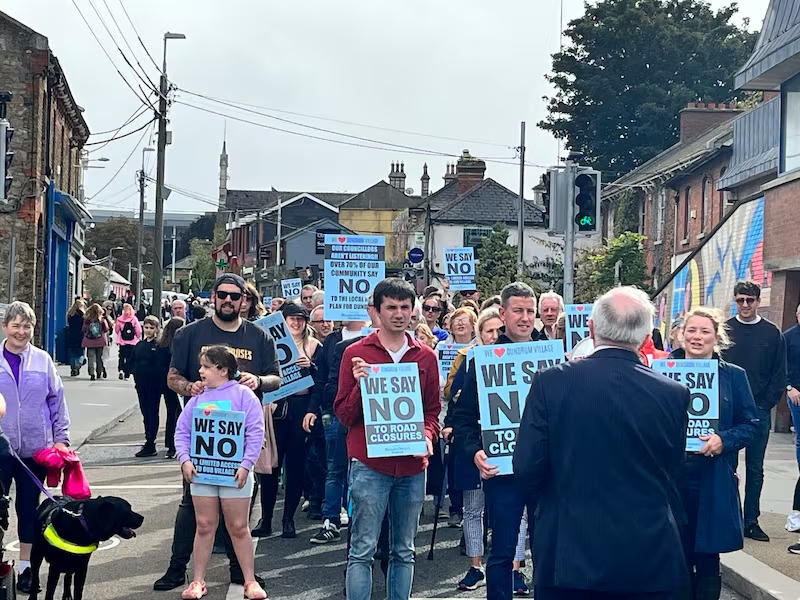Hundreds of people marched through Dundrum in south Dublin on Sunday afternoon to protest plans by Dún Laoghaire-Rathdown County Council to close access routes into and through the village.
Restrictions would be imposed on car access to Main Street if new one-way systems are introduced and existing one-way routes are extended, as proposed under the council’s Dundrum Local Area Plan (LAP).
The village’s main street is at the centre of the plan, which envisages a large-scale development across 168 hectares (415 acres) of suburban space, including land at Fernbank, the original Dundrum Shopping Centre, the former Notre Dame School site and adjoining open space and the Dundrum Business Park.
The council has said traffic restrictions are required to stop the area being choked by private cars, to provide safe routes for children going to school and to provide for a better public realm.
READ MORE
Residents at Sunday’s march, however, said the plans were not considerate of those currently living in Dundrum who use Main Street to access the church, doctors, chemists, shops, banks and schools.
[ Dundrum residents turn out in hundreds to object to council’s redevelopment plansOpens in new window ]
Addressing the protest outside the Holy Cross Church, GP Ciaran Bent said many locals “will not be able to enter the village”. He said restrictions and one way systems already introduced affected five roads and 10 lanes of traffic.
He said the plan would cause restrictions to 16 lanes of traffic across roads to the south of the village. This, he said, would pose significant difficulties for emergency services trying to get to the area.
Rachel Gerrard, of the Churchtown Residents’ Association, said “cars are necessary, especially for people with mobility issues” in accessing doctors, chemists and services. “Anyway,” she added, “we pay our car tax we are entitled to use the road.”

Hilary Roche, chairwoman of the board of management at a local school, accused the council of being guilty of bad faith in introducing current restrictions as temporary measures during the Covid-19 pandemic.
“You could live up in Holywell and work in the Long Mile Road – the plan doesn’t think of these people. It excludes them. It is not an inclusive plan,” she said.
Ruth Deveney, whose family owns an off-licence, and Peter Mulvey, whose family have, for generations, operated a hardware business, both on the Main Street, were critical of provisions for existing businesses.
Ms Devaney said the response appeared to be that people could “shop online or in the shopping centre”.
Mr Mulvey said deliveries would be extremely difficult and “you can’t get a tradesman to walk 500 metres with a heavy toolbox”.
Local Green Party councillor Daniel Dunn, when contacted by The Irish Times, said many motorists did not appreciate that sharing road space was better for everybody.
[ What is in the proposed new Dundrum Local Area Plan?Opens in new window ]
He said BusConnects and the Luas offered improved public transport access. He also said the local area plan was wider than just the traffic restrictions and would impose additional planning restrictions on the intensity of development in the area.
Fine Gael councillor Jim O’Leary said he was aware of local concerns in relation to the impact on traffic, and was “working with the other Dundrum councillors to try and solve that issue”.
He said: “Some want us to reject this plan but if we do that we make it more likely that the heritage of the village will be lost, that we will get over-development of the area and that we will not get a matching increase in local services. If this plan is rejected the earliest we will get to reconsider something will be after the adoption of a new County Development Plan in 2028. I think that would be a missed opportunity for the broader community.”
In a statement, the council said it was “not realistic” to pursue “business as usual” approach to managing traffic in Dundrum.
The “existing road network is heavily focused on the private car” and there was a requirement for “some reallocation of road capacity so we can provide for safe pedestrian and cycle facilities as well as priority for buses,” it said. “As a result of the proposed changes, some rerouting of local traffic flows would be required.”
















